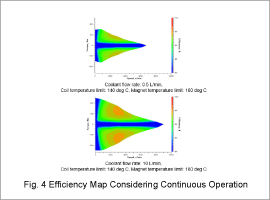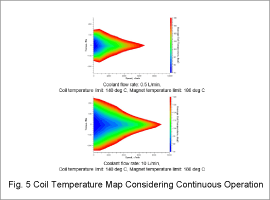Overview
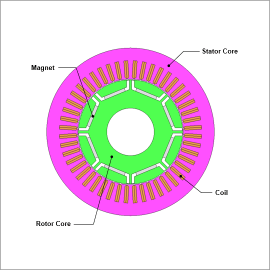
Simulations that use temperature-dependent efficiency maps can account for the interaction between the magnetic field and thermal characteristics. Efficiency maps created based on these results more closely approximate the actual machine for the short-time rating. JMAG enables users to configure thermal circuits that use a variety of cooling models. This includes a cooling jacket component that accounts for temperature variations of the coolant as well as components to combine hollow shaft and spray cooling.
This case study runs various IPM motor analyses to create efficiency maps by applying a temperature limit for motors running in a continuous duty cycle and short-time duty cycle.
Analysis Flow
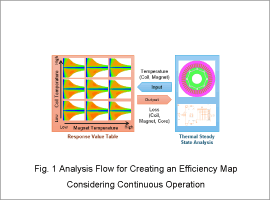
The magnetic field analysis study (efficiency map analysis) generates multiple efficiency maps that include temperature-dependent loss data for both the coils and magnets.
Next, the thermal analysis study (continuous drive characteristics analysis) runs steady-state thermal analyses by positioning operating points according to the efficiency maps obtained by the magnetic field analysis (efficiency map analysis). The simulation runs multiple steady-state thermal analyses at each operating point to integrate the temperature dependency of heat sources in each part obtained in the magnetic field analysis (efficiency map analysis) with the steady-state temperatures obtained by each thermal analysis. This process obtains efficiency maps that include the current, loss, and various other characteristics that account for continuous operation. Moreover, the temperature limits set for the efficiency maps exclude any operating points that exceed the temperature limit to obtain only N-T curves and efficiency maps during continuous operation that fall within these temperature constraints.
The same procedure can also create efficiency maps for the short-time rating. However, the thermal simulation runs a short-time operation characteristics analysis and transient thermal analyses for each operating point.
Comparison of Characteristics without Temperature Limits versus Continuous/Short-time Ratings
Fig. 2 compares the N-T curves for characteristics with parts at 60 deg C versus characteristics for continuous/short-time ratings that account for the temperature limits. Fig. 3 presents the efficiency maps. The continuous/short-time ratings set an upper temperature limit of 140 deg C for the coil, an upper temperature limit of 180 deg C for the magnets, and a coolant flow rate of 2 L/min. The drive time for the short-time rating is 300 seconds in this case study.
As the N-T curves illustrate in Fig. 2, the motor without temperature limits has the highest torque followed by the short-time rating and continuous rating because the temperature rise in the magnets reduces the torque and the temperature limits influence the characteristics.
As the efficiency maps indicate in Fig. 3, the maximum efficiency for the continuous rating is about 0.6 points less than the motor without temperature limits while the short-time rating is roughly 0.2 points lower.
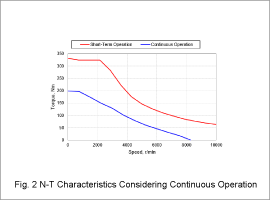
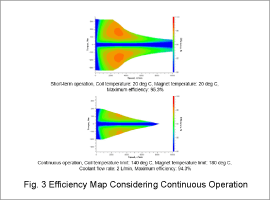
Influence of Coolant Flow Rate on Drive Duty Characteristics
This case study creates two different efficiency maps for the continuous rating and for the short-time rating by using two different coolant flow rates: 0.5 L/min and 10.0 L/min. Fig. 4 presents efficiency maps with a temperature limit for the coil and magnet. Fig. 5 provides an efficiency map based on the coil temperature. Fig. 6 provides efficiency maps based on the copper losses of the coil. The continuous/short-time ratings set an upper temperature limit of 140 deg C for the coil and an upper temperature limit of 180 deg C for the magnets. The short-time rating had a 300 second drive cycle.
As illustrated by Fig. 4, the torque increases with the high coolant flow rate (10.0 L/min) because of the better cooling performance. The torque decreases with the low coolant flow rate (0.5 L/min) in the very low-speed region because slow rotation speeds lower shaft cooling performance.
As shown in Fig. 5, better cooling performance mitigates coil heat at each operating point. However, regardless of the coolant flow rate, heat in the coils does approach the temperature limit on the outer edges of the N-T curves. The higher coolant flow rate does enhance cooling performance and reduces heat though, which prevents that heat from reaching the temperature limit more broadly throughout the motor.
The efficiency maps in Fig. 6 indicate a high coolant flow rate (10 L/min) that does have some operating points with larger copper losses than the low coolant flow rate (0.5 L/min). However, the better cooling performance enables the motor to run within the temperature limits, even at operating points generating more heat.
These characteristics are significant for the continuous rating, but the same phenomenon is also seen in the short-time rating. A simulation for the short-time rating provides an even more accurate evaluation.
